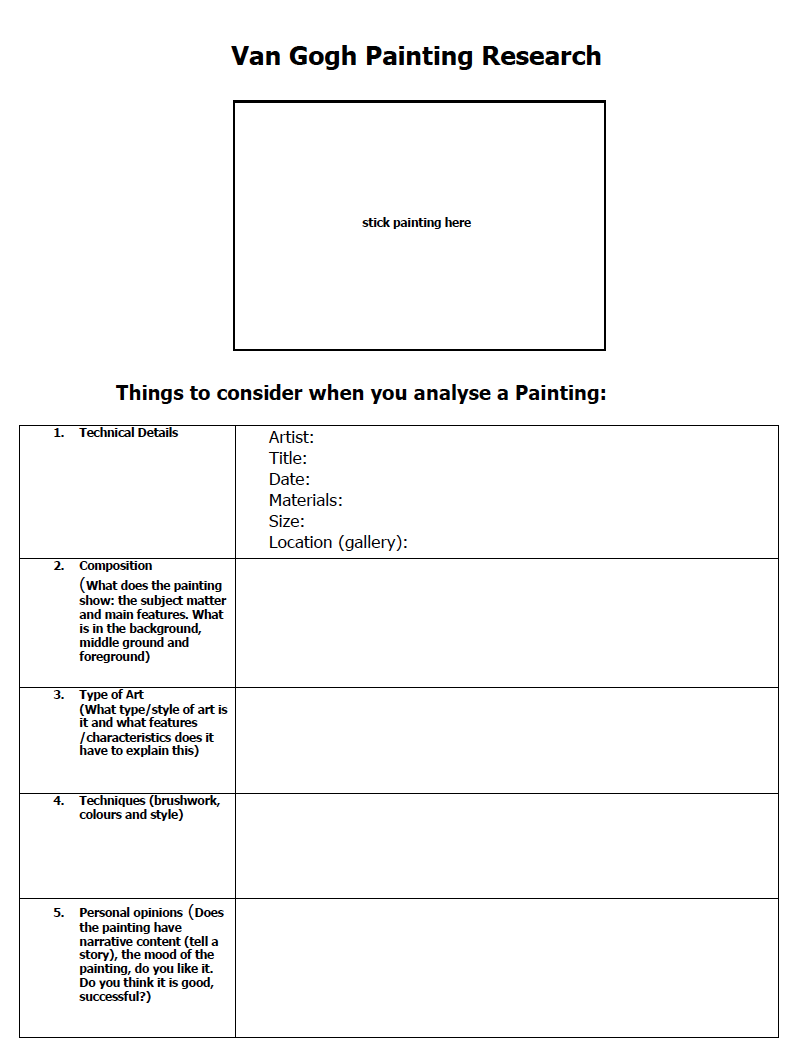Year 7 - Analysis of a Painting Unit
( if you miss the lesson for any reason you should still complete both classwork and homework)
This unit of work is about:
Art Criticism
Researching and writing about art and artists in detail
UNIT ARTISTS: Vincent van Gogh, James Whistler
UNIT VOCABULARY: Art Critic, Analysis of a Painting, Technical Details, Composition, Meaning, Subject Matter, Historical Information, Narrative Content/Story, Composition, Background, Middle ground, Foreground, Style, Painting Techniques, Colour/Palette
Research Art Criticism, Fact, Personal Opinion, Descriptive Details
Lesson 1
Classwork : Students learn how to formally analyse a work of art. They will research Van Gogh (his life and techniques, and also research one of van Gogh’s paintings of their choice to analyse). Firstly Students watch the ‘How to Analyse a Painting’ video and afterwards discuss the quality of Dr Bean’s analysis.
How to Analyse a Painting
After the video students should thing about the quality of Mr Bean’s analysis of the painting.
It’s very short
There is almost no technical or historical information about the painting
Mr Bean does however tell us his personal opinions about the work (but these might be more intelligent if he’d actually done some research about the artist and the painting)
Next students take notes when watching the two Vincent van Gogh videos below. Students should make notes on van Gogh’s life from the ‘15 Things You Didn't Know About Vincent van Gogh’ video, and on his techniques from the ‘Vincent van Gogh’s Style of Painting’ video. The aim should be to record 10 -20 pieces of information for secure from each video (10 is secure- and 20 is excellent-) neatly in your sketchbook.
15 Things You Didn't Know About Vincent van Gogh
Vincent van Gogh’s Style of Painting
Homework : Choose a well known van Gogh painting to analyse and collect relevant facts about the painting in preparation for completing the full written analysis essay over the next two lesson. Use the ‘Analyse of a van Gogh Painting Research Sheet’ below to collect information.
Lesson 2
Classwork : This is the first of two lessons where student start to write the van Gogh painting analysis (most student write 2-3 pages). Students will have already completed the general class research notes on van Gogh and specific research notes on a van Gogh painting. See examples below,
1. Initial class notes on van Gogh’s life and general artwork and techniques (20 - 40 bullet points on one or two sketchbook pages).
2. Homework notes on the ‘Analyse of a van Gogh Painting Research Sheet’
Work will be completed on lined paper, only working on one side as the essay will be stuck into sketchbooks when complete. Remember the essay combines both class notes and homework research in high quality descriptive writing . The vocabulary used and quality of your English language will be crucial. The essay will be set out and be set out in five paragraphs. See pictures below (the coloured sections will be explained next lesson).
Technical details
Composition/Meaning/story behind the work
Type or Style of art
Techniques used (including colours and painting process)
Personal Opinions (the best essays also have personal opinions include in all paragraphs - except paragraph 1)
Homework : No homework unless students feel they need to do extra research for the van Gogh painting analysis.
Lesson 3
Classwork : Student complete the van Gogh painting analysis. Those students who finish before the end of the lesson can start the heading part of the Portrait Proportions Worksheet for Lesson 4 (using guidelines and high quality lettering/ presentation).
Homework : Complete van Gogh painting analysis
Then use two different colour pencils (yellow and red) to underline/highlight the 3 best examples of descriptive personal comments (yellow pencil) and also the 3 best examples of research information such as facts or quotes (red pencil). See example shown in Lesson 2.




